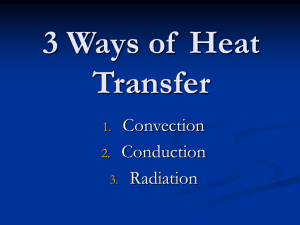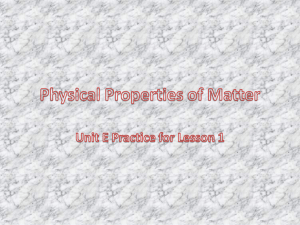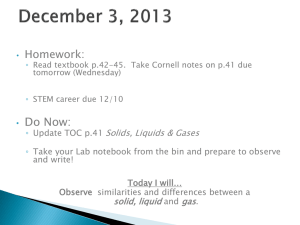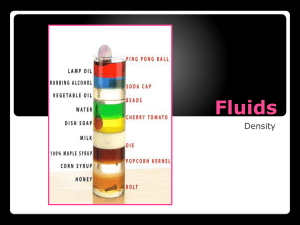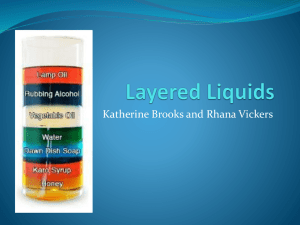Liquids and Solids
advertisement
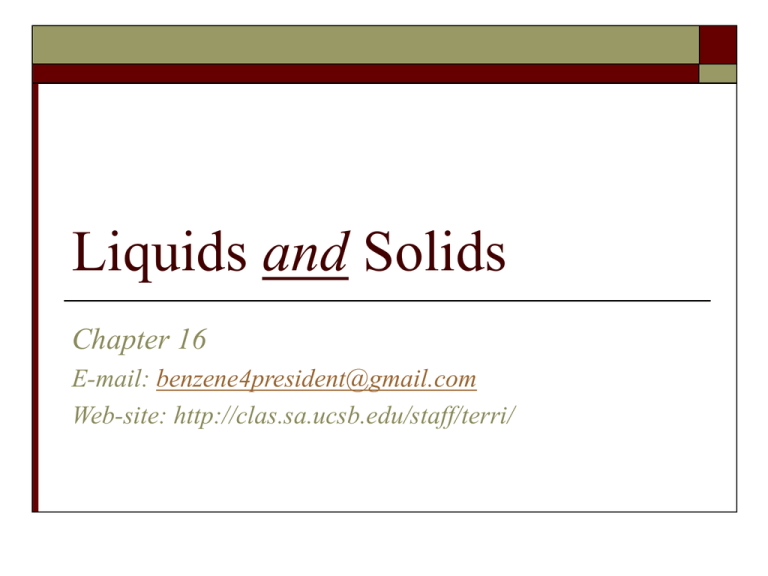
Liquids and Solids Chapter 16 E-mail: benzene4president@gmail.com Web-site: http://clas.sa.ucsb.edu/staff/terri/ Liquids and Solids – ch. 16 Liquids and Solids – ch. 16 1. Indicate the types of forces present and the type of solid for each of the following substances: a. CCl4 h. KOH b. HF i. BH3 c. NH4Br j. H2CO d. F2 k. SiO2 e. CH3OH l. Ar f. Ca m. P g. H2S n. S8 Liquids and Solids – ch. 16 Dipole-Dipole Hydrogen Bonding Only for molecules with dipole moments aka polar molecules A particularly strong dipole-dipole only for molecules with hydrogen bonded to O, N or F London Dispersion Forces Liquids and Solids – ch. 16 2. Using intermolecular forces predict the following: a. highest melting point F2 or Br2 b. highest melting point HF or HCl c. highest boiling point HOCH2CH2OH or CH3CH2OH d. highest boiling point CH3CH3 or CH3CH2CH3 e. highest vapor pressure CH3CH2OH or CH3OCH3 f. highest vapor pressure CCl4 or CH2Cl2 g. highest freezing point MgO or H2O h. highest surface tension C14H30 or C24H50 Liquids and Solids – ch. 16 Relative strength of forces ⇒ Ionic > >> Hydrogen bonding > Dipole-Dipole > Dispersion for molecules comparable in size Dispersion Forces 1. Increase with molecular size 2. Decrease with the degree of branching ex: As the attractive forces get stronger… 1. Boiling point ↑ 2. Freezing point ↑ 3. Melting point ↑ 4. Heat of fusion ↑ 5. Heat of vaporization ↑ 6. Viscosity ↑ 7. Surface Tension ↑ 8. Vapor Pressure ↓ 9. Volatility ↓ Liquids and Solids – ch. 16 Liquids and Solids – ch. 16 3. Copper has an inter-planar spacing of 1.36 Å. Calculate the wavelength of the X ray that should be used if θ is 15° (assume n=1). Liquids and Solids – ch. 16 Liquids and Solids – ch. 16 4 Types of Unit Cells for Metallic solids 1. Simple Cubic: 1 atom/unit cell 3. Face-centered Cubic or Cubic Closest Packed: 4 atoms/unit cell abc hexagonal alignment of atoms 2. Body-centered Cubic: 2 atoms/unit cell 4. Hexagonal Closest Packed: 2 atoms/unit cell abab hexagonal alignment of atoms Liquids and Solids – ch. 16 2 Types of closest packing 1. abab – hexagonal closest packed 2. abca – cubic closest packed Liquids and Solids – ch. 16 Counting Atoms in a Cubic Unit Cell Atom is shared between 2 unit cells Atom is shared between 4 unit cells Atom is shared between 8 unit cells Liquids and Solids – ch. 16 Unit Cell Simple Cubic Number of atoms/unit cell – (% by volume) 1 (52.4%) Coordination Number Edge Length as a function of atomic radius 6 e = 2r 𝑒= 4𝑟 Body Centered Cubic 2 (68%) 8 Face Centered Cubic aka Cubic Closest Packed 4 (74%) 12 𝑒=𝑟 8 (e = 2.828r) 12 N/A Hexagonal Closest Packed 2 (74%) 3 (e = 2.309r) Liquids and Solids – ch. 16 4. Zinc crystallizes in a cubic closest packed structure. The radius of a zinc atom is 135 pm. Calculate the density in g/mL for solid zinc. Liquids and Solids – ch. 16 5. Titanium metal has a body-centered cubic unit cell. The density is 4.50 g/cm3. Calculate the atomic radius in angstroms of titanium. (1010Å= 1m) Liquids and Solids – ch. 16 6. Consider the following cubic closest packed structures. For each compound determine where the ions are in the lattice. a. NaCl (Na+ = 95 pm, Cl– = 181 pm ) b. ZnS (Zn2+= 74 pm, S2– = 184 pm) c. CaCl2 (Ca2+ = 99 pm, Cl– = 181 pm) Liquids and Solids – ch. 16 Ionic Solids Anions (or the larger ion) will align themselves in the lattice points of the unit cell Cations (or the smaller ion) will occupy the holes created by the lattice points In FCC aka CCP lattices there are 3 types of holes: a. Trigonal holes are occupied when the radius of the cation is less than 22% of the anion – very rare b. Tetrahedral holes (8 available) are occupied when the radius of the cation is between 22% and 41% of the anion c. Octahedral holes (4 available) are occupied when the radius of the cation is between 41% and 73% of the anion Liquids and Solids – ch. 16 7. Identify the type of doping in each of the following. a. Gallium doped with tin b. Antimony doped with germanium c. A material is made from Al, Ga, and As. The mole fractions of these elements are 0.25, 0.26, and 0.49, respectively. Liquids and Solids – ch. 16 Doping ⇒ enhancing the conductivity of a semiconductor by adding a trace amount of an impurity (aka the dope) 2 Different Types of doping: a. n-type ⇒ impurity has more valence electrons in a valence shell with higher energy than the semiconductor b. p-type impurity has fewer valence electrons in a valence shell with lower energy than the semiconductor Si has 4 valence electrons As (the dope) has 5 valence electrons Si has 4 valence electrons B (the dope) has 3 valence electrons Liquids and Solids – ch. 16 M.O. model illustrating doping and how it enhances conductivity n-type doping p-type doping Liquids and Solids – ch. 16 8. Consider the following phase diagrams for water and carbon dioxide respectively – which phase is the most dense for each substance? How does pressure affect the MP and BP for each substance? Liquids and Solids – ch. 16 pressure melting Solid freezing Liquid vaporization condensation Equilibrium lines sublimation deposition Gas temperature Liquids and Solids – ch. 16 9. Pure compound Z has a triple point at 18 ° C and 72 torr, a normal melting point at 21 °C, and a normal boiling point at 87 °C. Which of the following statements regarding compound Z is/are correct? a. The density of the solid is greater that that of the liquid. b. Sublimation occurs if starting with a solid at a constant temperature of 17 °C the pressure is decreased until a phase change occurs. c. Condensation occurs if the temperature is decreased from 55 °C to 13 °C at a constant pressure of 1.00 atm. Liquids and Solids – ch. 16 10. The enthalpy of vaporization for water is 44 kJ/mol. What is the boiling point if the atmospheric pressure were 0.33 atm? ln P2 = −ΔHvap 1 − 1 P1 R T2 T1 Liquids and Solids – ch. 16 11. How much heat does is required to take 10 g of ice at -31 °C to vapor at 155 °C? (Csolid = 2.03 J/g°C , Cliquid = 4.18 J/g°C , Cgas = 2.02 J/g°C, ΔHfus = 6.01 kJ/mol, and ΔHvap = 40.7 kJ/mol) Liquids and Solids – ch. 16 Heating curve for water q = n Δ Hfus q = n Δ Hvap q = mcΔT Liquids and Solids – ch. 16 12. Determine the final temperature if a 25 g cube of ice at -7 °C is placed in 180 mL of water at 64 °C and allowed to come to equilibrium. (Csolid = 2.03 J/g°C , Cliquid = 4.18 J/g°C , Cgas = 2.02 J/g°C, ΔHfus = 6.01 kJ/mol, and ΔHvap = 40.7 kJ/mol) Liquids and Solids – Answer Key 1. Indicate the types of forces present for each of the following: a. CCl4 => dispersion b. HF => H-bonding and dispersion c. NH4Br => ionic d. F2 => dispersion e. CH3OH => H-bonding, dipole-dipole and dispersion f. H2S => dipole-dipole and dispersion g. KOH => ionic h. BH3 => dispersion i. H2CO => dipole-dipole and dispersion 2. Using intermolecular forces predict the following: a. Br2 b. HF c. HOCH2CH2OH d. CH3CH2CH3 e. NH3 f. CCl4 g. MgO h. C24H50 3. Copper has an inter-planar spacing of 1.36 Å. Calculate the wavelength of the X ray that should be used if θ is 15° (assume n=1). nλ=2dsinθ => (1)(λ)=2(1.36 Å)(sin 15°) => λ = 0.70 Å or 7nm Liquids and Solids – Answer Key 4. Zinc crystallizes in a cubic closest packed structure. The radius of a zinc atom is 135 pm. Calculate the density in g/mL for solid zinc. D = mass/volume => since cubic closest packed has 4 atoms per unit cell => mass of unit cell = 4(65.39amu)(1g/6.022x1023amu) = 4.34x10-22g The volume of the unit cell is edge3 => e3=(2.828(1.35x10-8cm)) 3 => 5.57x1023cm3 D = (4.34x10-22g)/(5.57x10-23cm3) = 7.8g/cm3 5. Titanium metal has a body-centered cubic unit cell. The density is 4.50 g/cm3. Calculate the atomic radius of titanium. Body centered cubic has 2 atoms per unit cell => mass of unit cell = 2(47.88amu)(1g/6.022x1023amu) = 1.59x10-22g => volume = m/d => volume = (1.59x10-22g)/(4.5g/cm3) = 3.53x10-23 cm3 => edge = (3.53x10-23 cm3 )1/3 = 3.29x10-8cm or 329pm => radius = 329pm/2.309 = 142pm Liquids and Solids – Answer Key 6. Compare the cubic closest packed structures for NaCl (radius of Na+ = 0.66 radius of Cl-), ZnS (radius of Zn2+ = 0.35 radius of S2-) and CaCl2 (radius of Ca2+ = 0.68 radius of Cl-). NaCl => Na+ will fill all of the octahedral holes ZnS => Zn2+ will fill all of the ½ of the tetrahedral holes CaCl2 => Ca2+ will fill ½ of the octahedral holes 7. Identify the type of doping in each of the following. a. Ga/Sn => n-type b. Si/B => p-type 8. What type of solid would you expect each of the following to form? a. KBr ionic b. H2S molecular c. SiO2 covalent network d. Pb atomic/metallic e. P atomic/covalent network f. Xe atomic g. CO2 molecular Liquids and Solids – Answer Key 9. Carbon dioxide Water Liquids and Solids – Answer Key 10. The enthalpy of vaporization for water is 44 kJ/mol. What is the boiling point if the atmospheric pressure were 0.33 atm? Since we know that the BP of water at 1 atm is 100°C we can figure out the BP at all other pressures using the ΔHvap ln(P1/P2) = (ΔHvap/R)(T2-1 – T1-1) ln(0.33atm/1atm) = (44kJ/mol/0.008314kJ/molK)(T2-1 – 373-1K) T2 = 405K 11. How much heat does is required to take 10 g of ice at -31 °C to vapor at 155 °C? (Csolid = 2.03 J/g°C , Cliquid = 4.18 J/g°C , Cgas = 2.02 J/g°C, ΔHfus = 6.01 kJ/mol, and ΔHvap = 40.7 kJ/mol) This is a 5 step process => 3 changes in temperature (q=mC Δ T) and 2 phase changes (q=n ΔH) Liquids and Solids – Answer Key q1=(10g)(2.03 J/g°C)(+31°C) = 629.3J or 0.629kJ q2=(10g/18g/mol)(6.01kJ/mol) = 3.34kJ q3=(10g)(4.18 J/g°C)(+100°C) = 4180J or 4.18kJ q4=(10g/18g/mol)(40.7 kJ/mol) = 22.6kJ q5=(10g)(2.02 J/g°C)(+55°C) = 1.11kJ qtotal = 31.86kJ 12. Determine the final temperature if a 25 g cube of ice at -7 °C is placed in 180 mL of water at 64 °C and allowed to come to equilibrium. (Csolid = 2.03 J/g°C , Cliquid = 4.18 J/g°C , Cgas = 2.02 J/g°C, ΔHfus = 6.01 kJ/mol, and ΔHvap = 40.7 kJ/mol) Heat is transferred from the hot water into the cold water -qhot = +qcold Liquids and Solids – Answer Key -mCΔT = mCsolid Δ T + nHfus +mCliquidΔ T -(180g)(4.18J/g°C)(Tf-64°C) =(25g)(2.03J/g°C)(7°C)+(25g/18g/mol)(6010J/mol)+(25g)(4.18J/g°C)(Tf-0°C) Tf = 46°C
